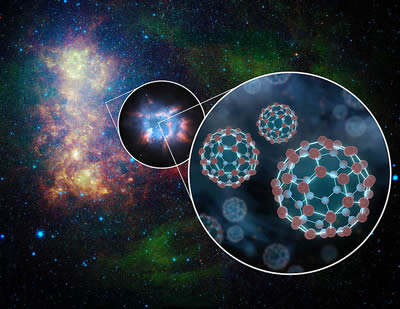Carbon definition

Diagram of Extragalactic Space Balls
©NASA Copyright free
Carbon (C) is the chemical element with six protons, six neutrons and six electrons. It forms many organic (relating to or coming from living matter) compounds by sharing four electrons with up to four other atoms. Many of these such as hydrocarbons, are found in fossil fuels. Carbon is a major ingredient in polymers such as plastics. Inorganic compounds of carbon include carbon monoxide and carbon dioxide as well as carbonates in oceans and rocks.
Carbon is the chemical basis of life and the fourth most abundant element in the universe. Humans are 18.5% carbon by mass.
As an element, carbon atoms bond with each other. They form the hard, transparent crystalline lattice that is diamond. Layered hexagonal rings of carbon atoms that slide easily over each other, appear black and conduct electricity, form graphite. Sometimes carbon atoms are found as a mess. Amorphous carbon, as it is called, makes up charcoal, coal and soot.
Carbon has been tinkered with as well. A ball of carbon with carbon atoms located in an arrangement similar to the vertices of a soccer ball containing 60 carbon atoms is formed by using electricity and graphite. Called buckyballs or buckminsterfullerene, their discovery was awarded the Chemistry Nobel Prize in 1996. His whole field of nanotechnology is rapidly growing and other shapes called nanotubes have also been developed. Some of these forms are now believed to occur in naturally in space. The 2010 the Physics Nobel Prize was won for the development of graphene, single atom layers of graphite. It has incredible properties of strength, elasticity and flexibility as well as heat and electrical conduction.
